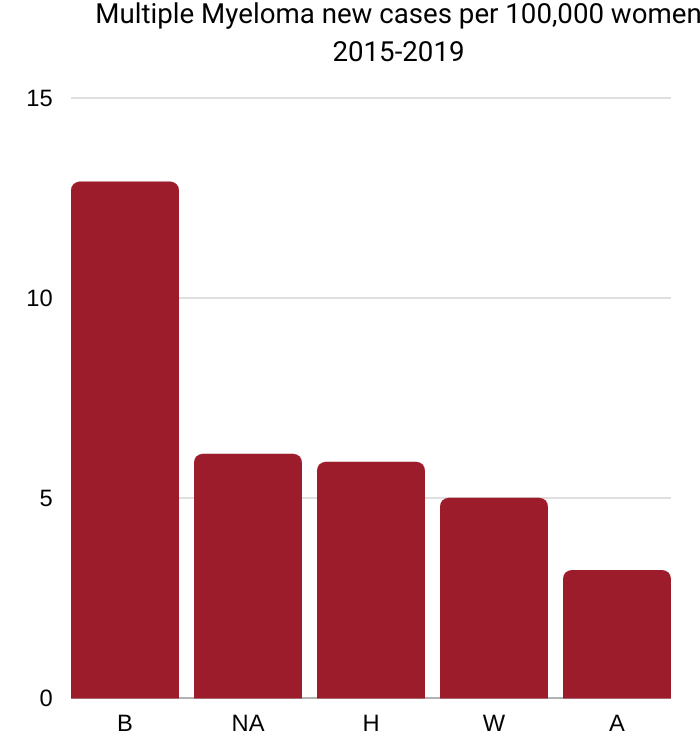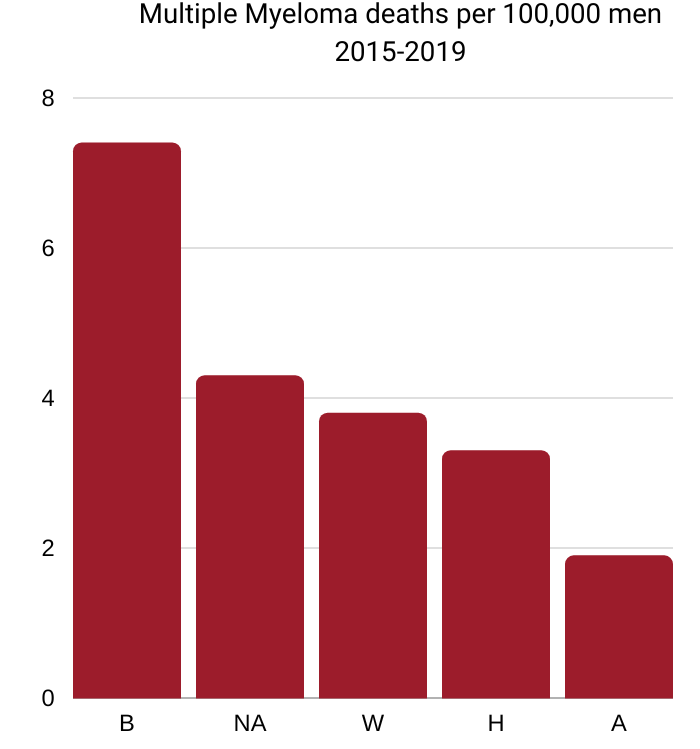Multiple Myeloma Disparities
- more than twice as likely to be diagnosed with multiple myeloma
- almost three times more likely to be diagnosed with multiple myeloma when younger than 50
- more than twice as likely to be diagnosed and at a younger age with MGUS, the precursor condition for multiple myeloma
- slightly more likely to survive for 5 years after diagnosis
- nearly three times more likely to be diagnosed with multiple myeloma
- almost four times more likely to be diagnosed with multiple myeloma when younger than 50
- more than twice as likely to be diagnosed and at a younger age with MGUS, the precursor condition for multiple myeloma
- slightly more likely to survive for 5 years after diagnosis
Data

B=Black 12.9, NA=Native American 6.1,
H=Hispanic 5.9, W=White 5.0, A=Asian/Pacific Islander 3.2
Source: National Cancer Institute
Cancer Stat Facts: Myeloma

B=Black 17.0, NA=Native American 9.1,
H=Hispanic 8.1, W=White 8.1, A=Asian/Pacific Islander 5.1
Source: National Cancer Institute
Cancer Stat Facts: Myeloma

B=Black 5.1, NA=Native American 2.8,
W=White 2.3, H=Hispanic 2.2, A=Asian/Pacific Islander 1.3
Source: National Cancer Institute
Cancer Stat Facts: Myeloma

B=Black 7.4, NA=Native American 4.3,
W=White 3.8, H=Hispanic 3.3, A=Asian/Pacific Islander 1.9
Source: National Cancer Institute
Cancer Stat Facts: Myeloma
Multiple Myeloma Disparities
Incidence
Black men and women. Incidence of myeloma is 2.14 times higher in Black men and 2.6 times higher in Black women compared to White people. Median age at diagnosis is younger (66 versus 70 years of age). Incidence continued to increase steadily in Black women by about 2% per year from 2009 through 2018, whereas rates in Black men may be stabilizing in recent years, resembling trends in White men.
Source: American Cancer Society. Cancer Facts & Figures for African American/Black People 2022-2024.
The racial disparity is even greater before age 50, when incidence rates are 2.5 times higher in Black men and 3.5 times higher in Black women.
Source: American Cancer Society. Cancer Facts & Figures for African Americans 2019-2021. Atlanta: American Cancer Society, 2019
Family history
Black men and women. A family history of blood cancers is also associated with increased risk that is stronger among Black people than White people.
Source: American Cancer Society. Cancer Facts & Figures for African American/Black People 2022-2024.
Stage at diagnosis
Myeloma is preceded by an asymptomatic premalignant condition known as monoclonal gammopathy of undetermined significance (MGUS). Individuals with MGUS have a risk of progression to myeloma of about 1% to 2% a year.
Black men and women. MGUS is more prevalent and diagnosed at earlier ages in Black people than people of any other racial/ethnic group.
Source: American Cancer Society. Cancer Facts & Figures for African American/Black People 2022-2024.
Aggressive disease
Black men and women. The somewhat higher contemporary survival among Black people may reflect a lower prevalence of aggressive disease.
Source: American Cancer Society. Cancer Facts & Figures for African American/Black People 2022-2024.
Clinical trials
Black men and women. Only 4.5% of participants were African Americans in U.S. clinical trials for new drugs to treat multiple myeloma between 2003 and 2017. Considering that African Americans account for 13% of the U.S. population and 20% of individuals diagnosed with multiple myeloma, their under-representation in these clinical trials raises concerns regarding the applicability of study results to this population.
Source: “Recommendations on Eliminating Racial Disparities in Multiple Myeloma Therapies: A Step toward Achieving Equity in Healthcare” (2021)
Treatment
Black men and women. Black people have benefited less from recent improvements in treatment because of less access to care, lower utilization of new treatment, and more delays in treatment.
Source: American Cancer Society. Cancer Facts & Figures for African American/Black People 2022-2024.
5-year survival
Black men and women. The 5-year relative survival rate has improved from 29% during 1975-1977 to 58% during 2011-2017 among Black people versus 24% to 55% among White people. The somewhat higher contemporary survival among Black people may reflect a lower prevalence of aggressive disease. Indeed, Black people have benefited less from recent improvements in treatment because of less access to care, lower utilization of new treatment, and more delays in treatment.
Source: American Cancer Society. Cancer Facts & Figures for African American/Black People 2022-2024.
Mortality
Black men and women. Mortality rates are about twice as high in Black people as in White people. During 2015-2019, myeloma death rates declined by about 3% per year in Black women and 1% per year in Black men and White men and women due to improved treatment.
Source: American Cancer Society. Cancer Facts & Figures for African American/Black People 2022-2024.
"most disturbing is that it is often not recognized in time"
“Multiple myeloma is a unique disease in the African American community for many reasons, primarily because the disease is twice as common in Blacks than it is in Caucasians,” says Joseph Mikhael, MD, of the International Myeloma Foundation.
“But what’s perhaps most disturbing is that despite knowing that it is twice as common, it is often not recognized and not recognized in time. The average time to diagnosis from the onset of symptoms to an accurate diagnosis is significantly longer in the African American community than it would be in the Caucasian community.
Unfortunately, African Americans are less likely to receive the combinations of chemotherapy that are so important, the stem cell transplants that are very important in the treatment of myeloma, and access to clinical trials.
All of that has led to an inferior survival rate in African Americans compared to Caucasians. We’ve seen huge advances in survival in myeloma over the last decade, but for every 1.3 years gained by Caucasian patients, we’ve only seen 0.8 years gained in Black patients.
The disparity in multiple myeloma is confined not only to the African American community. We see this in many other vulnerable communities, in particular the Hispanic community where the disease is diagnosed at a younger age than we would typically see in the Caucasian community.”
A 3-minute video from the Patient Empowerment Network.
How Multiple Myeloma Affects People of Color

African Americans tend to have a better prognosis with multiple myeloma when they receive timely diagnosis and standard treatment, writes Shamard Charles, MD.
Research shows that disparities in multiple myeloma survival within the African American community stem from inferior treatment utilization and access rather than underlying pathogenesis. Unfortunately, many African-American people with multiple myeloma are not presented with life-saving options.
This underscores the importance of not only increasing health literacy in Black communities to help empower people to serve as their own advocates but also eliminating bias in the healthcare system.
See “Multiple Myeloma in the African American Community” by By Shamard Charles, MD, on the Verywell Health website (January 25, 2021)
Multiple Myeloma in African Americans

Researchers have discovered important differences in key cancer genes between African American and Caucasian myeloma patients.
African American myeloma patients were shown to have a lower-risk genetic profile and thus should achieve treatment results equal to—or even better than—those seen in other myeloma patient populations.
But barriers to appropriate treatment and lack of awareness of the disease (on the part of both patients and community health care providers) contribute to treatment approaches inconsistent with current recommended practice.
To overcome these barriers and more effectively manage their disease, African American patients need to stay informed about these unique disease and management considerations.
See “Multiple Myeloma in African Americans” on the Multiple Myeloma Research Foundation website (August 26, 2019)
